Geo-Identity of the Most Exploited Underground Obsidian Deposit in Mesoamerica: Cartography, Petrography, and Geochemistry of the Sierra de las Navajas, Hidalgo, Mexico
Abstract
1. Introduction
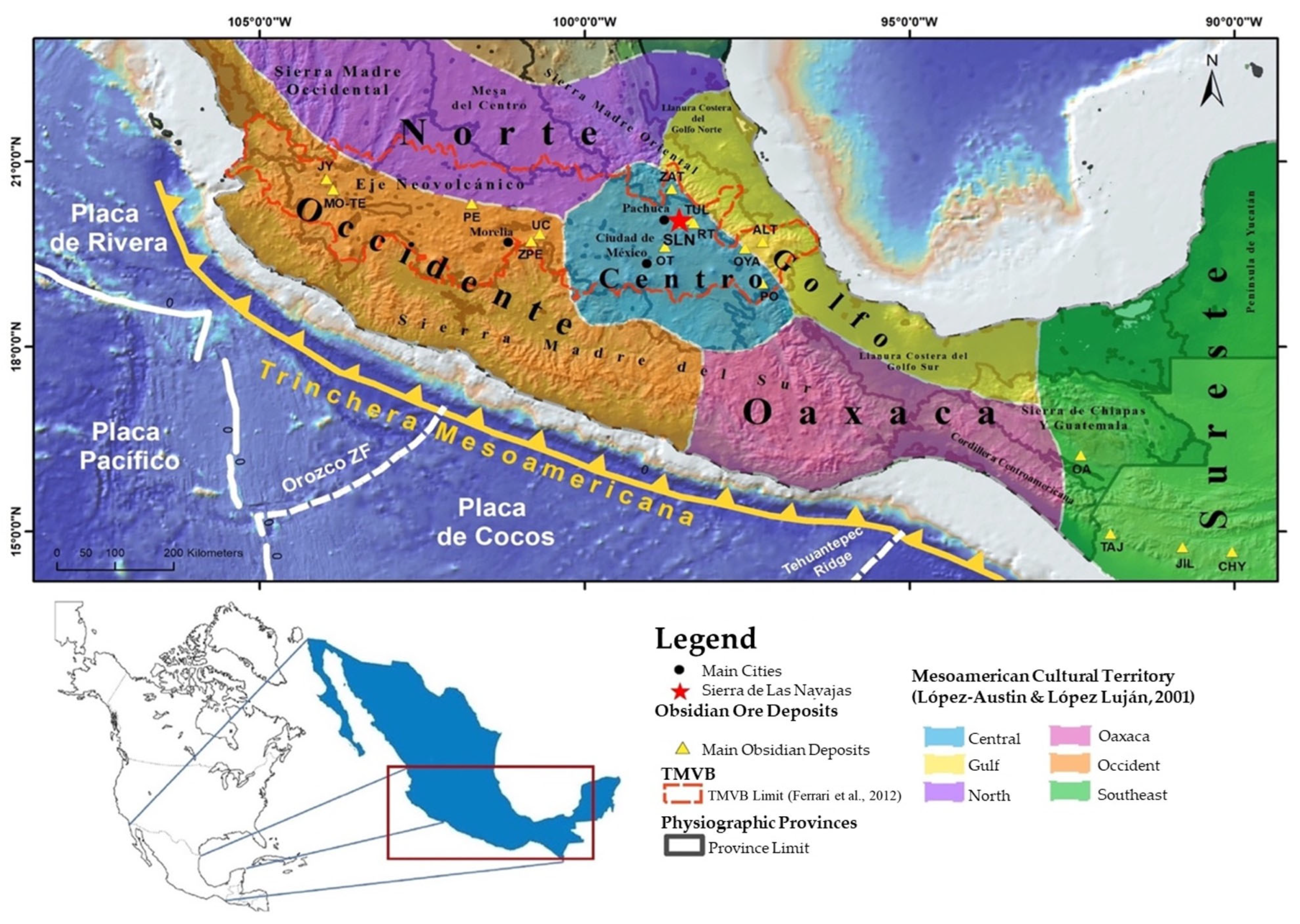
2. Materials and Methods
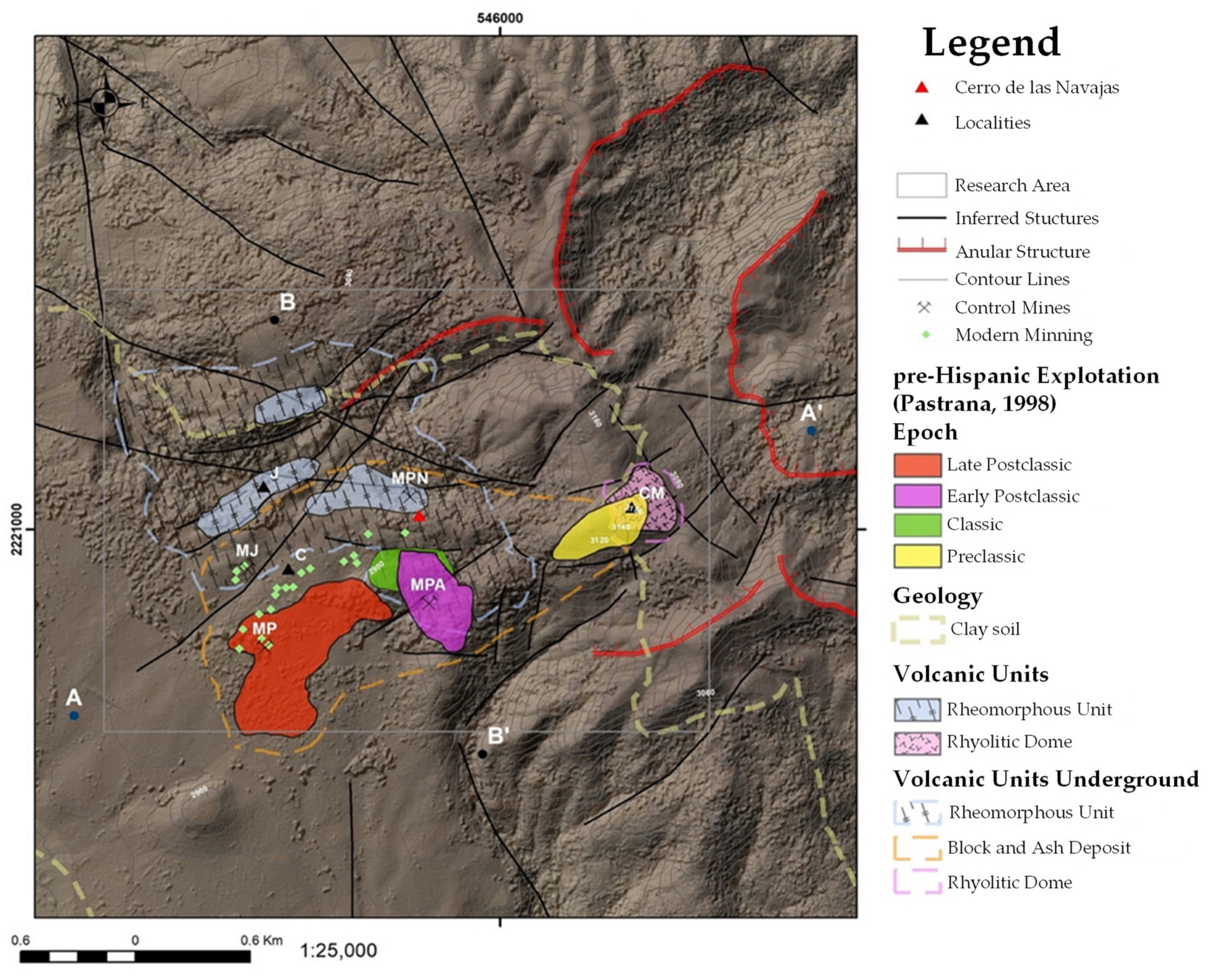
3. Results
3.1. Geology of Cerro de las Navajas
3.2. Petrography and X-Ray Diffraction
3.3. Geochemistry
4. Discussion
4.1. Concept of Subsources: Sierra de las Navajas and Color Origin in Green Obsidian
4.2. Origin of Cerro de las Navajas and Green-Gold Obsidian
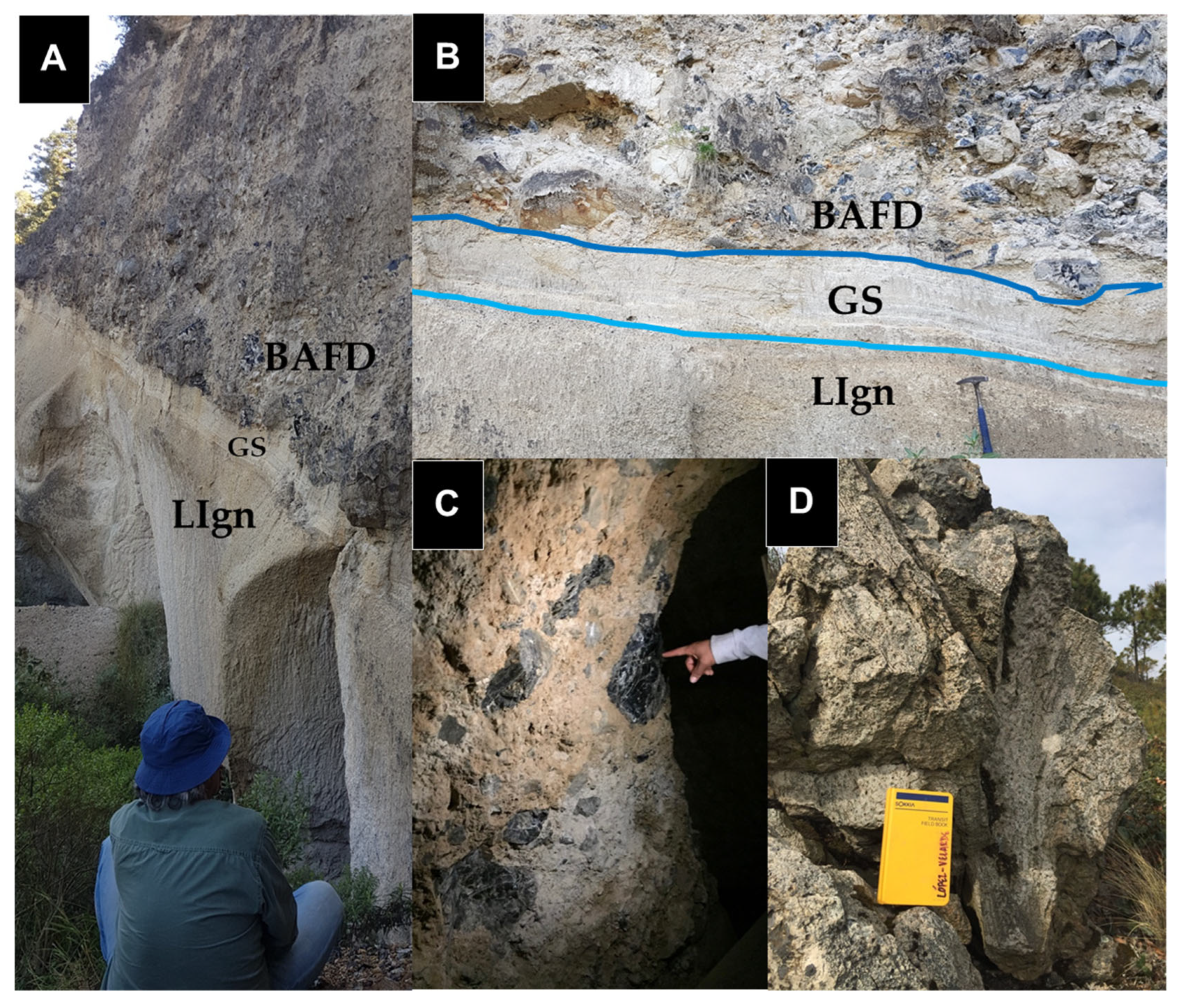
4.3. Pre-Hispanic Exploitation of Obsidian at Cerro de las Navajas
5. Conclusions
Author Contributions
Funding
Data Availability Statement
Acknowledgments
Conflicts of Interest
References
- Cobean, R.H. Un Mundo de Obsidiana: Minería y Comercio de un vidrio volcánico en el México Antiguo. In A World of Obsidian: The Mining and Trade of a Volcanic Glass in Ancient Mexico; Instituto Nacional de Antropología e Historia: Mexico City, Mexico, 2002. [Google Scholar]
- Ramírez, Q.; Véronique Darras, O. Caracterización espacial de un paisaje de extracción prehispánico: El yacimiento de dacita de Las Minas, Zacapu, Michoacán. In Ancient Mesoamerica; Cambridge University Press: Cambridge, UK, 2023; pp. 1–29. [Google Scholar] [CrossRef]
- Breton, A. Journey to Mexico, 1893–1897: Archaeological Tours and Sketches; Methuen & Co.: London, UK, 1905. [Google Scholar]
- Breton, A. Sketches and Descriptions of Mexican Obsidian Artefacts. J. Anthropol. Res. 1898, 2, 112–120. [Google Scholar]
- Ordoñez, E. Las Riolitas de México. Bol. Inst. Geol. México 1900, 14, 7–75. [Google Scholar]
- Cruz-Pérez, M.; Canet, C.; Pastrana, A.; Domínguez-Peláez, S.; Morelos-Rodríguez, L.; Salgado-Martínez, E.; Krieger, P.; Martínez-Serrano, R.G. La Obsidiana Verde y Dorada del Cerro de las Navajas: Caso de Estudio Geoarqueológico en el Geoparque Mundial de la UNESCO “Comarca Minera”, Hidalgo, México (resumen). In Proceedings of the En V Simposio Latinoamericano y del Caribe de Geoparques, Trinidad, Uruguay, 4–8 November 2019. [Google Scholar]
- Ferrari, L.; Orozco-Esquivel, T.; Manea, V.; Manea, M. The dynamic history of the Trans-Mexican Volcanic Belt and the Mexico subduction zone. Tectonophysics 2012, 522, 122–149. [Google Scholar] [CrossRef]
- Lopéz, A.; Lopéz, L. Mexico’s Indigenous Past; University of Oklahoma Press: Norman, OK, USA, 2001. [Google Scholar]
- Pastrana, A. La Explotación Azteca de la Obsidiana en la Sierra de las Navajas; Instituto Nacional de Antropología e Historia: Ciudad, Mexico, 1998; 282p. [Google Scholar]
- Pastrana, A.; Domínguez, S. Cambios en la estrategia de la explotación de la obsidiana de Pachuca: Teotihuacan, Tula y la Triple Alianza. Anc. Mesoam. 2009, 20, 129–148. [Google Scholar] [CrossRef]
- Ponomarenko, A.L. The Pachuca obsidian source, Hidalgo, Mexico: A geoarchaeological perspective. Geoarchaeology 2004, 19, 71–91. [Google Scholar] [CrossRef]
- Lopez-García, P.; Argote, D.L.; Beirnaert, C. Chemometric analysis of Mesoamerican obsidian sources. Quat. Int. 2019, 510, 100–118. [Google Scholar] [CrossRef]
- Caretta, M.N.; Tinoco, B.L. (Eds.) Expresiones Materiales del poder en el Contexto Arqueológico del México Prehispánico; Universidad Autónoma de San Luis Potosí: San Luis Potosí City, Mexico, 2020; Bornholms Museum; El Colegio de Michoacán A.C; pp. 161–190. Available online: https://www.academia.edu/41836183/Expresiones_Materiales_del_Poder_en_el_Contexto_Arqueol%C3%B3gico_del_M%C3%A9xico_Prehisp%C3%A1nico (accessed on 28 January 2025).
- Campbell, S.; Healey, E.; Kuzmin, Y.; Glascock, M.D. The mirror, the magus and more: Reflections on John Dee’s obsidian mirror. Antiquity 2021, 95, 1547–1564. [Google Scholar] [CrossRef]
- Donato, P.; Donato, S.; Barba, L.; Crisci, G.M.; Crocco, M.C.; Davoli, M.; Filosa, R.; Formoso, V.; Niceforo, G.; Pastrana, A.; et al. Influence of Chemical Composition and Microvesiculation on the Chromatic Features of the Obsidian of Sierra de las Navajas (Hidalgo, Mexico). Minerals 2022, 12, 177. [Google Scholar] [CrossRef]
- Donato, P.; Barba, L.; De Rosa, R.; Niceforo, G.; Pastrana, A.; Donato, S.; Crisci, G. Green, grey and black: A com-parative study of Sierra de las Navajas (Mexico) and Lipari (Italy) obsidians. Quat. Int. 2017, 467, 369–390. [Google Scholar] [CrossRef]
- Vidal-Solano, J.R.; Gómez-Valencia, A.M.; Velderrain-Rojas, L.A. Prácticas de Laboratorio y Campo Para Petrología de Rocas Magmáticas; Serie Manuales de Prácticas; Universidad de Sonora: Hermosillo, Mexico, 2022; 103p. [Google Scholar] [CrossRef]
- Ochoa-Alcalá, D.A.; y Vidal-Solano, J.R. Geoquímica por FRX-ED semi-portátil en secciones y polvos de rocas volcánicas básicas del Mioceno superior en la región costera sur de Sonora, México: Utilidades y ventajas en la aplicación de estudios petrológicos. Actas INAGEQ V 2020, 26, 30–39. [Google Scholar]
- Vidal-Solano, J.R.; Gómez-Valencia, A.M.; Hinojo-Hinojo, A.; Lozano-Santa Cruz, R. Handheld X-ray fluorescence geochemical data of geological and archaeological obsidian from Sonora, Mexico. Data Brief 2020, 33, 106410. [Google Scholar] [CrossRef] [PubMed]
- López-Velarde, G.A. Geoarqueología de los Yacimientos de Obsidiana con Explotación Prehispánica en la Sierra de las Navajas, Hidalgo, México: Origen e Identidad Petrológica. MSc. Thesis, Departamento de Geologia, Universidad de Sonora, Hermosillo, Mexico, 2020; 177p. [Google Scholar]
- Lighthart, A. The Geology, Petrology and Geo-Archaeology of Sierra las Navajas, Hidalgo, Mexico. Ph.D. Thesis, Tulane University, New Orleans, LA, USA, 2001. [Google Scholar]
- Nuñez-Velázquez, M. Volcán las Navajas, Estado de Hidalgo: Características Geoquímicas e Isotópicas del Magmatismo Peralcalino en la Faja Volcánica Trans-Mexicana; Universidad Nacional Autónoma de México: Mexico City, Mexico, 2018. [Google Scholar]
- Martínez-Serrano, R.G.; Núñez-Velázquez, M.V.; Contreras-Cruz, D.; García-Tovar, G.P.; Torres-Peralta, M.A.; Solís-Pichardo, G. On the unusual presence of a Quaternary peralkaline volcanic center, rear-arc region of the Trans-Mexican Volcanic Belt eastern sector: Geochemical and isotopic characterization of the Las Navajas–Hidalgo stratovolcano. Int. J. Earth Sci. 2022, 111, 1983–2015. [Google Scholar] [CrossRef]
- Argote-Espino, D.; Solé, J.; López-García, P.; Sterpone, O. Obsidian Subsource Identification in the Sierra de Pachuca and Otumba Volcanic Regions, Central Mexico, by ICP-MS and DBSCAN Statistical Analysis. Geoarchaeology 2012, 27, 48–62. [Google Scholar] [CrossRef]
- Vicencio, A.G.; López Corral, A.; Mitrani, A.; Arciniega, A.; Carballo, D.M. Characterization of obsidian subsource variability at El Paredón, Mexico. Archaeometry 2023, 65, 1215–1231. [Google Scholar] [CrossRef]
- Tykot, R.H.; Glascock, M.D.; Speakman, R.J.; Atzeni, E. Obsidian Subsources Utilized at Sites in Southern Sardinia (Italy). Mater. Res. Soc. Symp. Proc. 2007, 1047, 106. [Google Scholar] [CrossRef]
- Cruz-Pérez, M.A.; Canet, C.; Pastrana, A.; Domínguez-Peláez, S.; Morelos-Rodríguez, L.; Carcavilla, L.; Salgado-Martínez, E.; Krieger, P.; García-Alonso, R.J.; Martínez-Serrano, R.G. Green and Golden Obsidian of “Cerro de Las Navajas”, Hidalgo (Mexico): Geoarchaeological Heritage That Deserves International Recognition. Geoheritage 2021, 13, 92. [Google Scholar] [CrossRef]
- Tenorio, A.; Cabral, P.; Bosch, M.; Jiménez-Reyes, S. Bulbulian. Differences in Coloured Obsidians from Sierra de Pachuca, Mexico. J. Archaeol. Sci. 1998, 25, 229–234. [Google Scholar] [CrossRef]
- Brown, R.J.; Andrews, G. Deposits of Pyroclastic Density Currents. In En H. Sigurdsson, The Encyclopedia of Volcanoes, 2nd ed.; Elsevier: Amsterdam, The Netherlands, 2015. [Google Scholar]
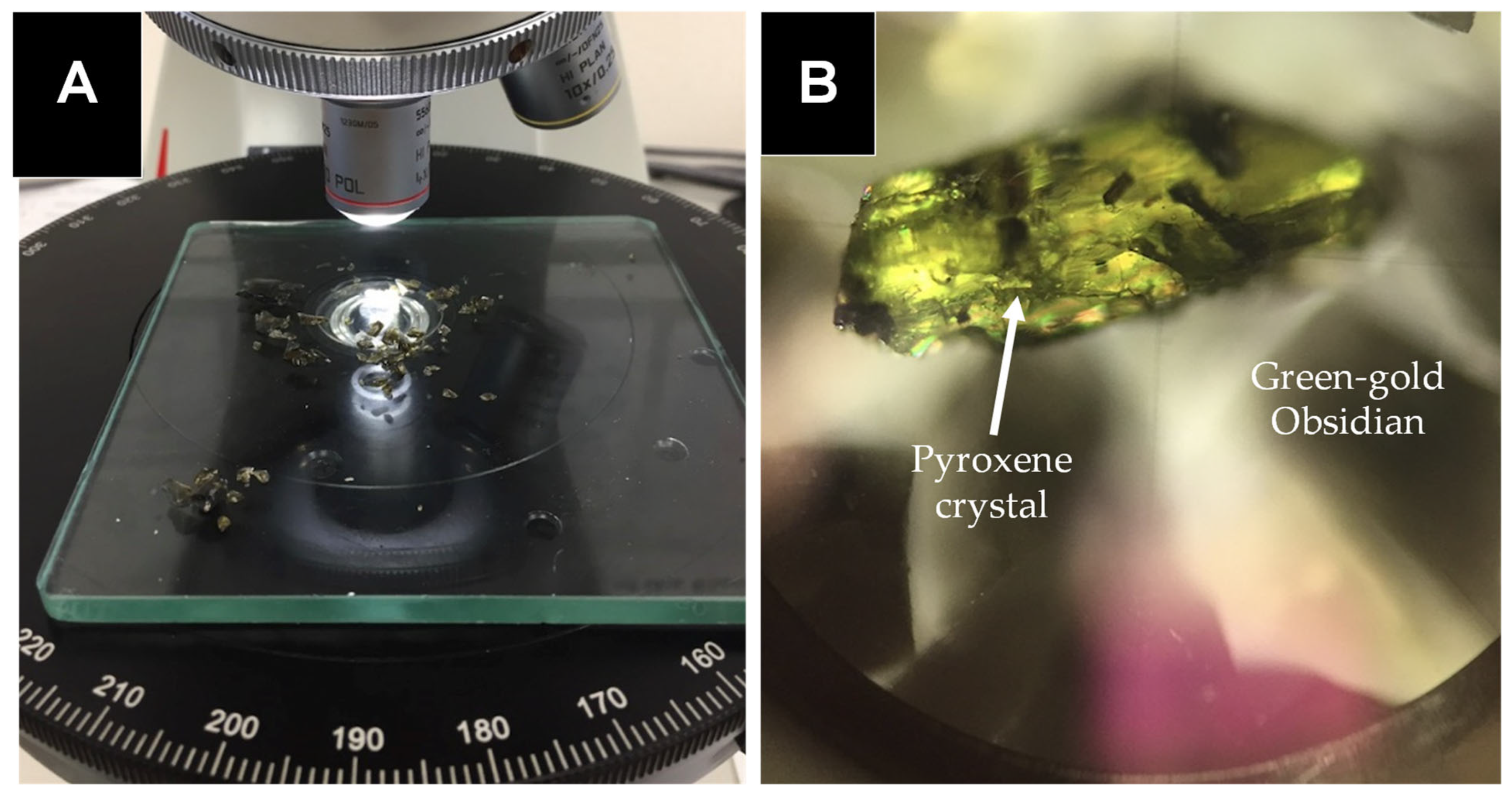
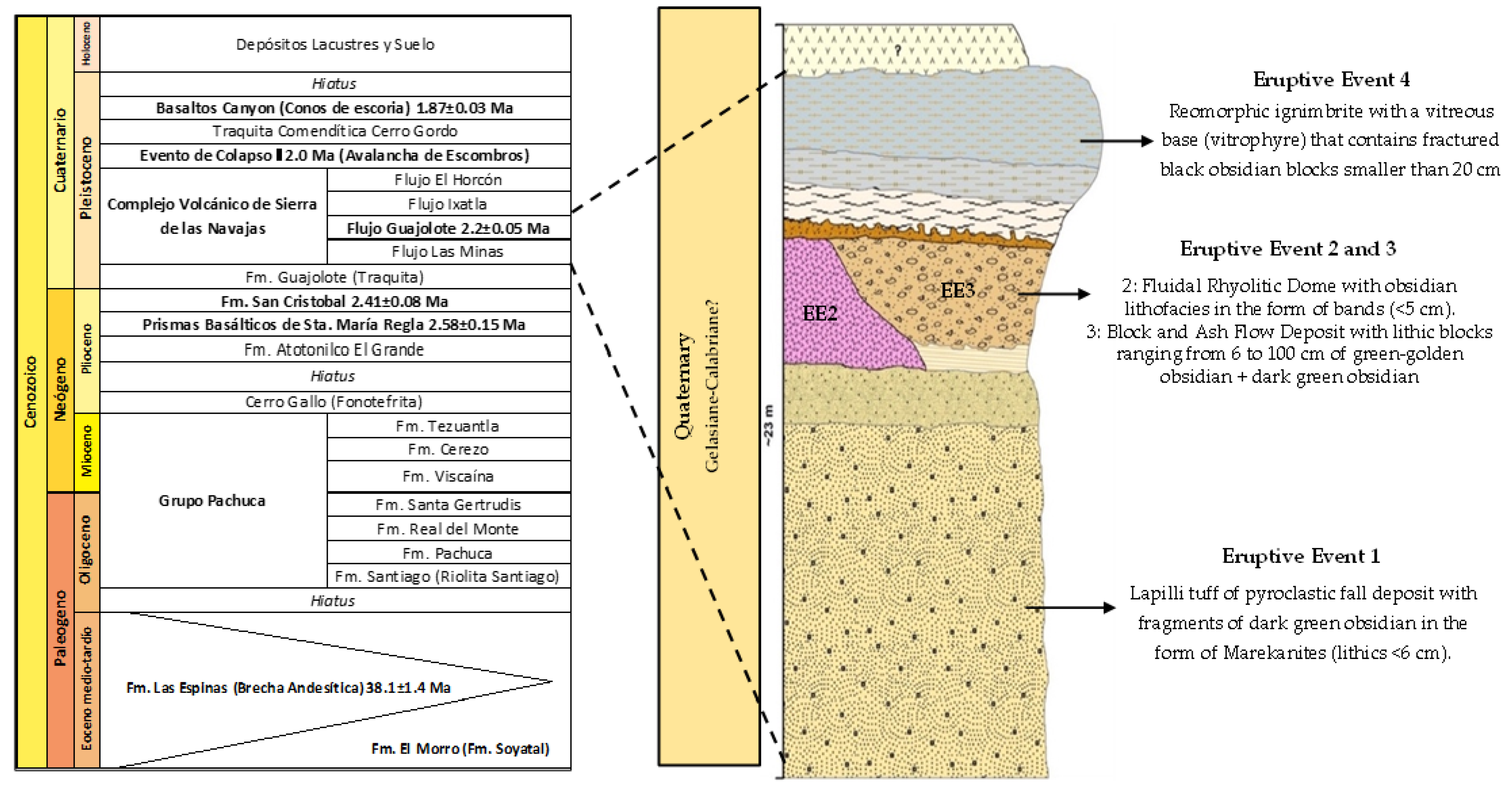
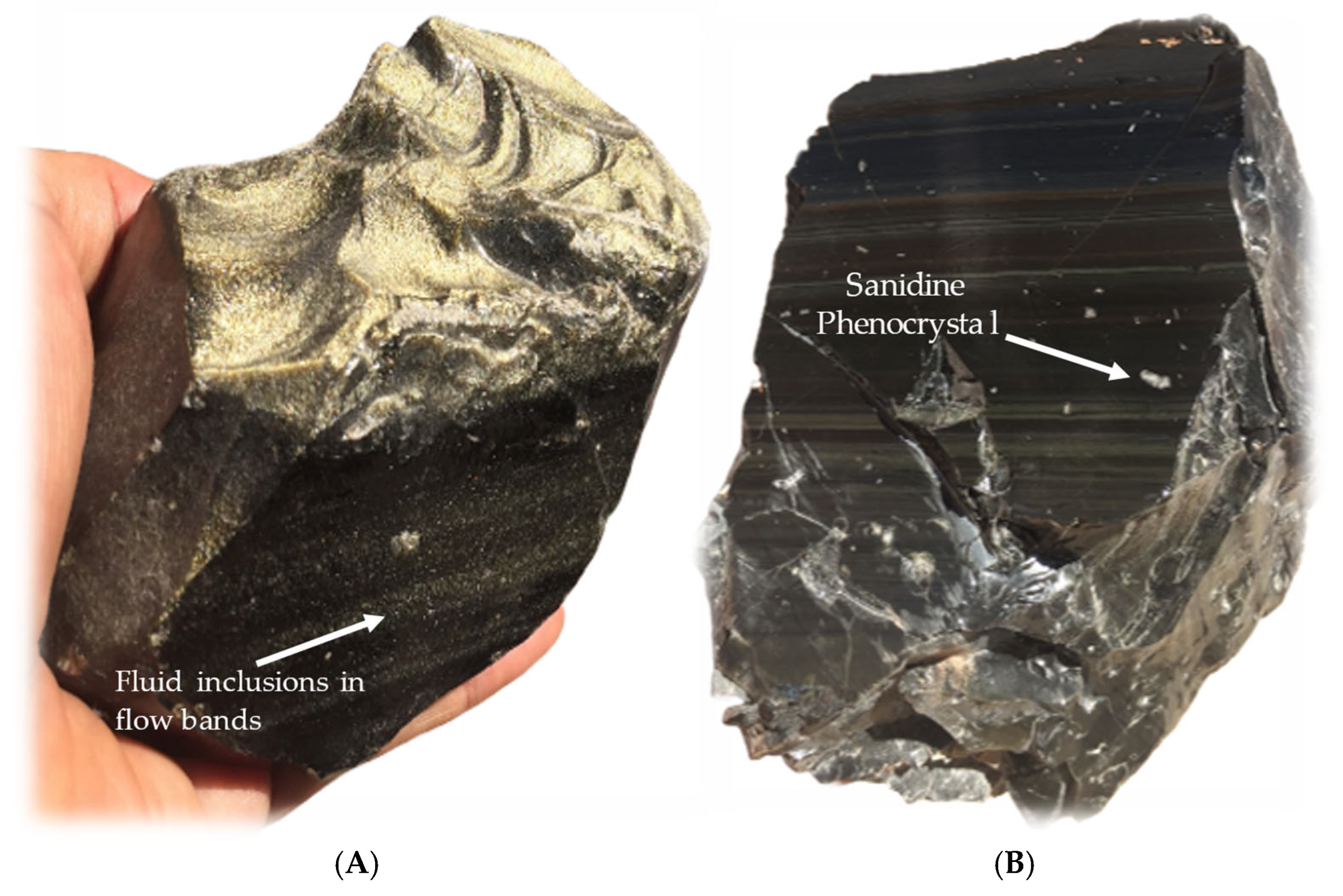
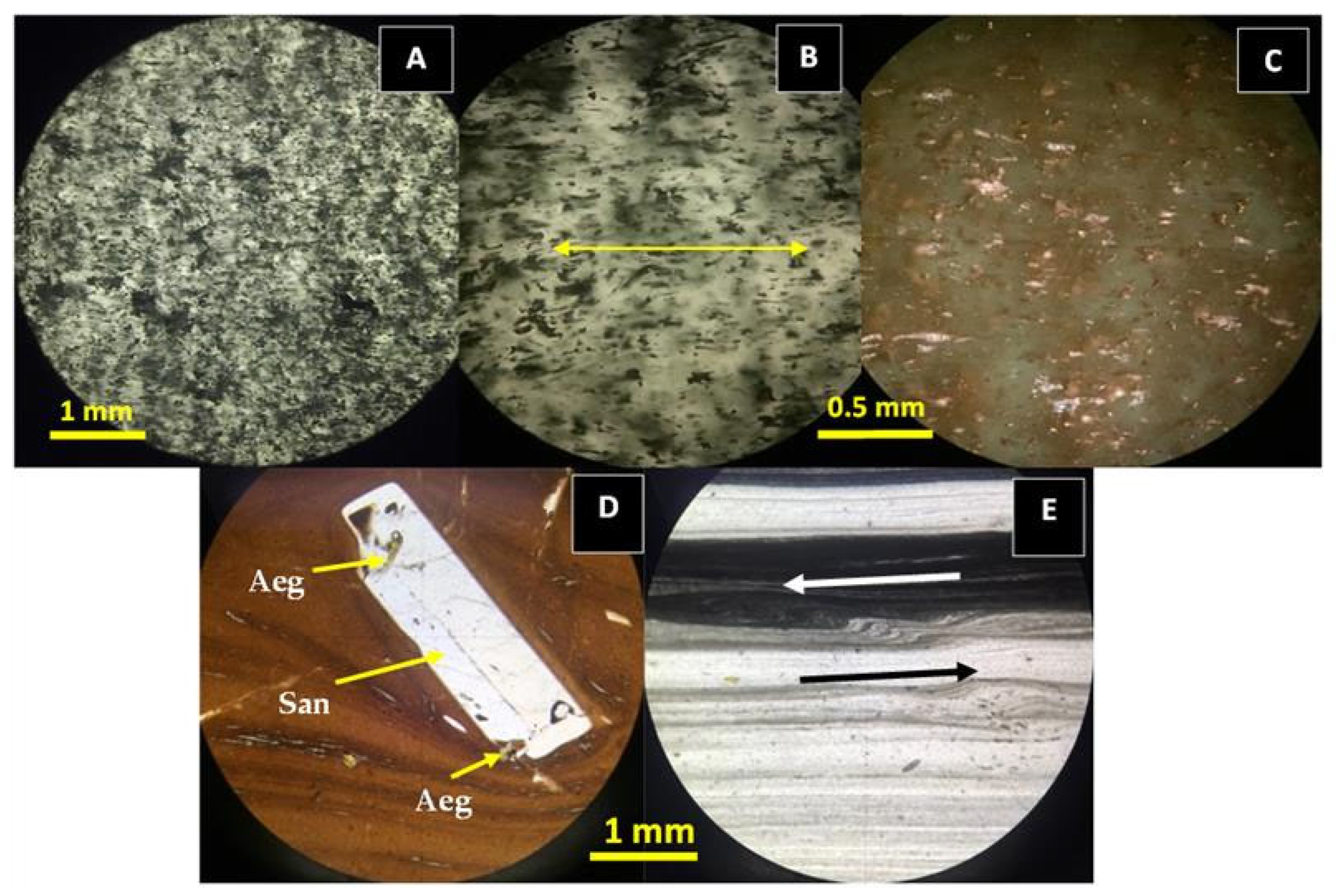


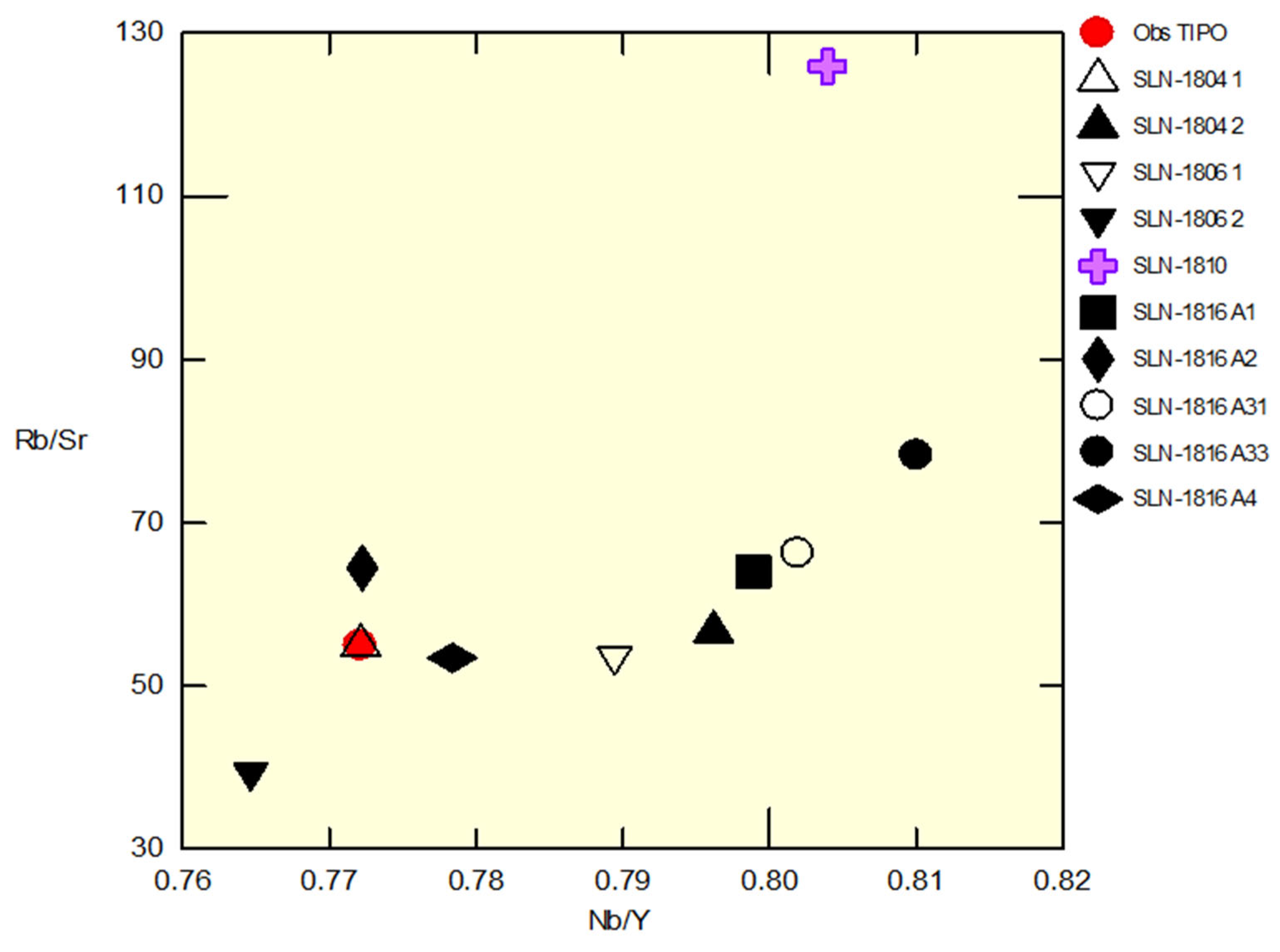
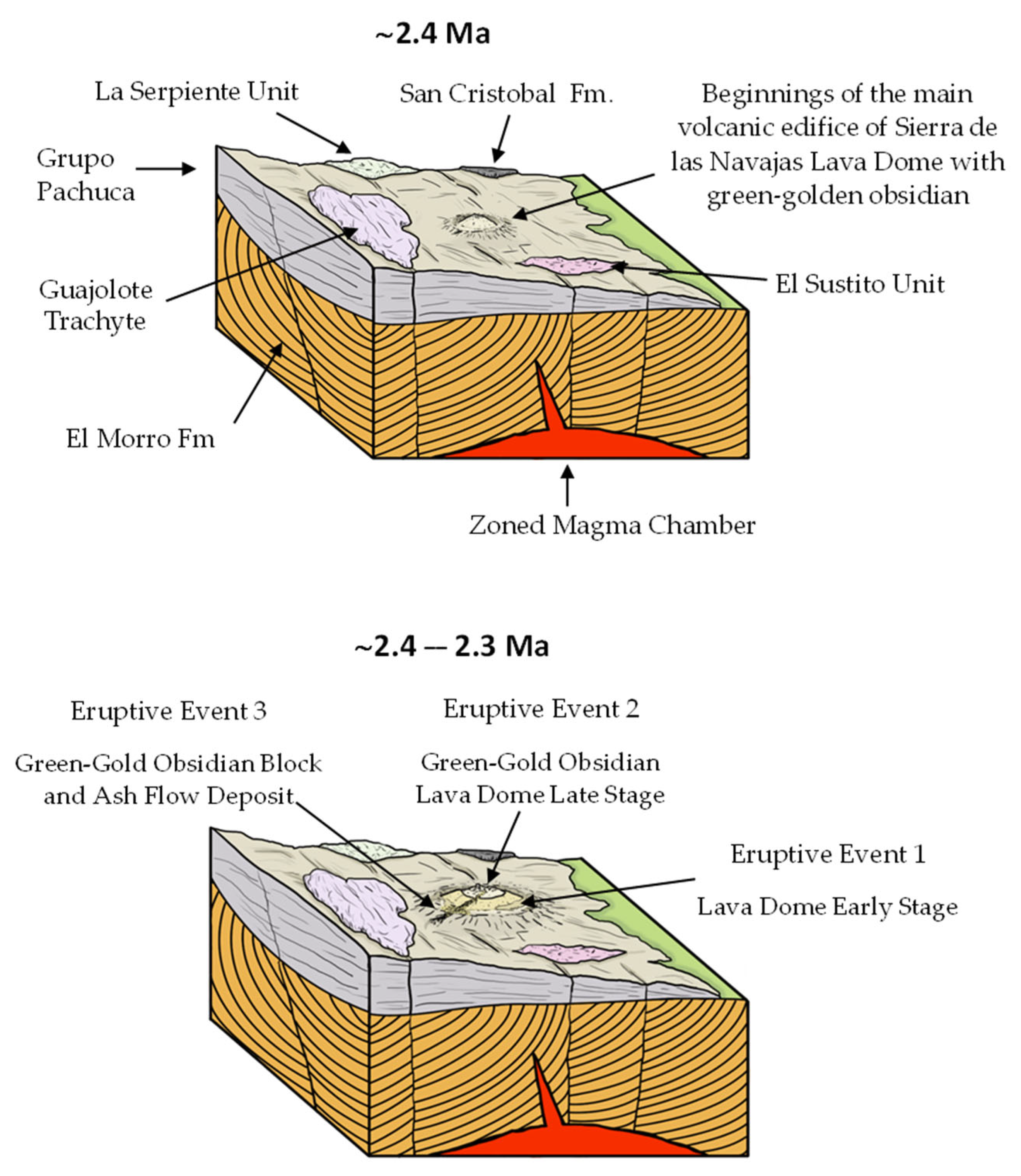
| Cerro de las Navajas Obsidians | Zr | Error | Sr | Error | Rb | Error | Zn | Error | Fe | Error | Mn | Error | Ti | Error | Ca | Error | K | Error | Nb | Error | Y | Error | |
|---|---|---|---|---|---|---|---|---|---|---|---|---|---|---|---|---|---|---|---|---|---|---|---|
| Green-Gold | SLN-1804 1 | 1187.44 | 7.18 | 4.01 | 0.91 | 231.58 | 4.16 | 243.67 | 9.17 | 17,032.26 | 133.13 | 958.04 | 45.09 | 986.78 | 29.70 | 693.94 | 53.68 | 29,324.37 | 208.25 | 108.44 | 2.75 | 140.44 | 3.41 |
| SLN-1804 2 | 1135.94 | 6.78 | 3.76 | 0.86 | 214.00 | 3.85 | 220.76 | 8.47 | 15,069.73 | 121.09 | 847.91 | 41.77 | 1049.36 | 29.92 | 663.73 | 53.00 | 29,010.87 | 206.72 | 104.93 | 2.61 | 131.79 | 3.18 | |
| SLN-1806 1 | 1232.01 | 7.23 | 4.58 | 0.92 | 243.64 | 4.19 | 263.94 | 9.40 | 17,929.23 | 134.22 | 1002.97 | 45.24 | 1072.06 | 31.04 | 603.13 | 54.84 | 31,657.63 | 217.86 | 113.98 | 2.76 | 144.38 | 3.39 | |
| SLN-1806 2 | 1365.81 | 11.98 | 4.89 | 1.07 | 154.52 | 3.96 | 390.89 | 14.53 | 27,562.30 | 202.67 | 2713.25 | 113.68 | 975.45 | 29.14 | 698.51 | 52.32 | 28,837.29 | 204.03 | 116.34 | 3.14 | 152.15 | 3.95 | |
| Marekanite | SLN-1810 | 1112.97 | 6.38 | 1.60 | 0.88 | 199.96 | 3.55 | 201.09 | 7.72 | 13,670.04 | 109.67 | 804.78 | 39.08 | 1161.58 | 32.35 | 728.42 | 57.80 | 31,268.45 | 226.83 | 101.83 | 2.45 | 126.66 | 2.96 |
| Dark Green | SLN-1816 A1 | 1091.17 | 6.37 | 3.26 | 0.81 | 197.42 | 3.59 | 200.52 | 7.77 | 13,775.01 | 111.75 | 800.58 | 39.42 | 1009.76 | 31.76 | 562.59 | 53.65 | 29,634.40 | 212.73 | 100.59 | 2.46 | 125.91 | 2.97 |
| SLN-1816 A2 | 1140.45 | 6.69 | 3.43 | 0.84 | 214.18 | 3.82 | 217.67 | 8.29 | 15,143.61 | 120.00 | 841.16 | 41.39 | 1013.86 | 29.95 | 681.24 | 53.81 | 30,193.29 | 211.25 | 104.74 | 2.58 | 135.63 | 3.17 | |
| SLN-1816 A31 | 1071.33 | 6.32 | 2.97 | 0.80 | 194.83 | 3.55 | 196.01 | 7.70 | 13,323.44 | 109.56 | 754.52 | 38.77 | 1127.85 | 30.76 | 717.42 | 53.76 | 29,126.22 | 209.28 | 98.48 | 2.44 | 122.80 | 2.94 | |
| SLN-1816 A33 | 1036.02 | 6.20 | 2.47 | 0.79 | 184.76 | 3.45 | 185.89 | 7.51 | 12,651.31 | 106.54 | 766.58 | 38.84 | 1017.90 | 30.16 | 725.44 | 54.40 | 29,374.00 | 211.38 | 94.71 | 2.39 | 116.92 | 2.86 | |
| SLN-1816 A4 | 1147.73 | 6.83 | 4.20 | 0.88 | 218.60 | 3.90 | 227.76 | 8.61 | 15,406.52 | 122.63 | 857.05 | 42.17 | 966.92 | 29.60 | 563.39 | 52.55 | 29,114.55 | 208.75 | 105.33 | 2.63 | 135.32 | 3.23 | |
Disclaimer/Publisher’s Note: The statements, opinions and data contained in all publications are solely those of the individual author(s) and contributor(s) and not of MDPI and/or the editor(s). MDPI and/or the editor(s) disclaim responsibility for any injury to people or property resulting from any ideas, methods, instructions or products referred to in the content. |
© 2025 by the authors. Licensee MDPI, Basel, Switzerland. This article is an open access article distributed under the terms and conditions of the Creative Commons Attribution (CC BY) license (https://creativecommons.org/licenses/by/4.0/).
Share and Cite
López-Velarde, G.A.; Vidal-Solano, J.R.; Pastrana, A. Geo-Identity of the Most Exploited Underground Obsidian Deposit in Mesoamerica: Cartography, Petrography, and Geochemistry of the Sierra de las Navajas, Hidalgo, Mexico. Minerals 2025, 15, 629. https://doi.org/10.3390/min15060629
López-Velarde GA, Vidal-Solano JR, Pastrana A. Geo-Identity of the Most Exploited Underground Obsidian Deposit in Mesoamerica: Cartography, Petrography, and Geochemistry of the Sierra de las Navajas, Hidalgo, Mexico. Minerals. 2025; 15(6):629. https://doi.org/10.3390/min15060629
Chicago/Turabian StyleLópez-Velarde, Gerardo Alonso, Jesús Roberto Vidal-Solano, and Alejandro Pastrana. 2025. "Geo-Identity of the Most Exploited Underground Obsidian Deposit in Mesoamerica: Cartography, Petrography, and Geochemistry of the Sierra de las Navajas, Hidalgo, Mexico" Minerals 15, no. 6: 629. https://doi.org/10.3390/min15060629
APA StyleLópez-Velarde, G. A., Vidal-Solano, J. R., & Pastrana, A. (2025). Geo-Identity of the Most Exploited Underground Obsidian Deposit in Mesoamerica: Cartography, Petrography, and Geochemistry of the Sierra de las Navajas, Hidalgo, Mexico. Minerals, 15(6), 629. https://doi.org/10.3390/min15060629







